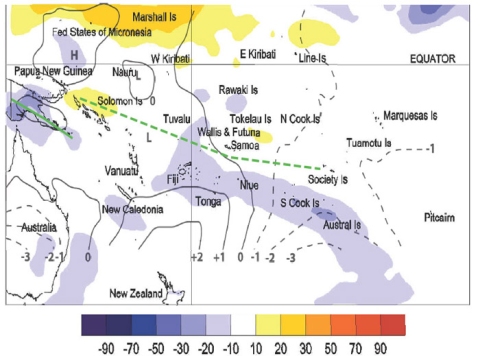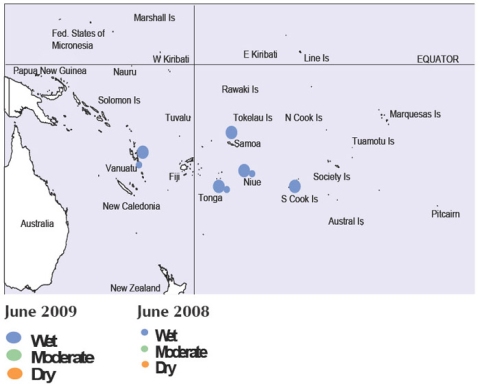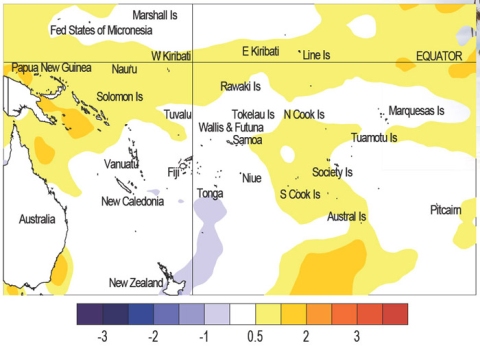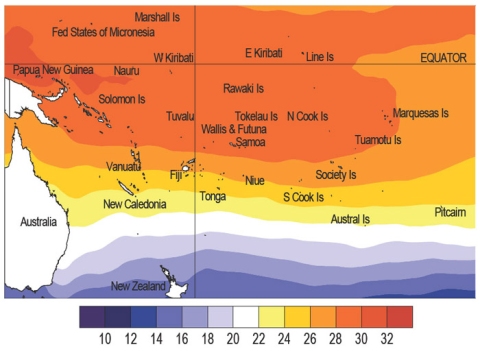Climate developments in June 2009.

Outgoing Long-wave Radiation (OLR) anomalies, in Wm2 are represented by hatched areas. High radiation levels (yellow) are typically associated with clearer skies and lower rainfall, while cloudy conditions lower the OLR (blue) and typically result in higher rainfall. The June 2009 position of the South Pacific Convergence Zone (SPCZ) was displaced southwest of its normal position, less extensive, and and weakly coherent compared to previous months. The average position of the SPCZ is identified by the dashed green line, which is based on mean January rainfall for the South Pacific. Mean sea level (MSL) pressure anomalies (in hPa) are shown as solid and dashed black lines.
The South Pacific Convergence Zone (SPCZ) was displaced slightly southwest of its normal position last month, but was contracted toward the Equator. The SPCZ exhibited less coherent rainfall in the northeast portion of the Southwest Pacific than in previous months. A region of enhanced rainfall was observed over part of Fiji and the Austral Islands during June. Suppressed convection existed northeast of Western Kiribati last month. The regional circulation in June was characterised by more frequent low pressure over Australia and south of the Austral Islands, and higher than normal pressure in the northwestern portion of the Tasman Sea to the north of New Zealand.
Near normal to above normal rainfall occurred in Papua New Guinea and New Caledonia in June. High rainfall was also recorded in Samoa, the Southern Cook Islands, and the southern fringe of French Polynesia. Stations in those areas all received more than 120% of normal rainfall for the month. Niue also received high precipitation, with more than 190% of normal rainfall recorded at Liku and Hanan. Very high rainfall fell at Niulakita in Tuvalu (see table below), which was a contrast to near or below normal rainfall for three other stations that reported for June. In Kiribati, Tarawa received well above normal rainfall (230mm; 143% of normal ) for the month. In Fiji, 80% of sites had average to above average rainfall, and three sites had greater than 200% of normal rainfall.
Drier than normal conditions occurred over much of northeast Australia, parts of Vanuatu, and much of the Solomon Islands during June. Low rainfall totals in the Solomon Islands occurred at Honiara and Henderson, which received 21% and 63% of normal rainfall, respectively. There were dry conditions in the Marquesas for the month of June, with about 75% of normal rainfall recorded in Gambier. Near normal rainfall was recorded for the Society Islands and the Tuamotu Archipelago.
Warmer than normal conditions occurred as a whole across French Polynesia, with +0.4°C to +1.6°C above normal temperatures. Increased frequency of easterly wind were recorded in the Marquesas and the northern part of the Tuamotu Archipelego. Across the Southwest Pacific in Fiji, air temperatures were average to below average, with some nights dipping below 15°C due to strong southerly flow.
| Island Group | Location | Rainfall (mm) | % of average | Comments |
|---|---|---|---|---|
| Solomon Islands | Honiara | 20 | 21 | Record low |
| Tuvalu | Nuilakita | 552 | 286 | Highest monthly total in the region |
| Papua New Guinea | Daru | 220 | 234 | High |
| Niue | Hanan | 200 | 222 | Very high |
| Australia | Cairns | 4 | 8 | Very low |
Soil moisture in June 2009

Estimates of soil moisture shown in the map (right) are based on monthly rainfall for one station in each country. Currently there are not many sites in the water balance model, but more stations will be included in the future. The information displayed is based on a simple water balance technique to determine soil moisture levels. Addition of moisture to the available water already in the soil comes from rainfall, with losses via evapotranspiration. Monthly rainfall and evapotranspiration are used to determine the soil moisture level and its changes. These soil moisture calculations were made at the end of the month, and for practical purposes, generalisations were made about the available water capacity of the soils at each site. Hanan (Niue), Apia (Samoa), Port Vila (Vanuatu), Raratonga (Southern Cook Islands) and Fua’amotu (Tonga) project moist soil moisture conditions.
El Niño/Southern Oscillation (ENSO)


During June, the equatorial Pacific Ocean exhibited ENSO–neutral characteristics. Sea surface temperatures (SSTs) in that region have been rising steadily since February, and are now almost +1°C warmer than normal across the equatorial Pacific. NINO3 and NINO 4 SST anomalies are +0.5°C and +1.0°C, respectively, for June (and +0.6°C and +0.3°C, respectively, for AMJ). Sea surface height anomalies along the Equator were mostly positive and the large anomalies in recent months west of the Dateline in the Southern Hemisphere show signs of weakening. Positive equatorial sub–surface ocean temperatures in the uppermost 100m near South America, which strengthened in May, continued to intensify with a +4°C anomaly appearing by the end of June. The upper ocean heat content (averaged over the top 300m) is positive across the equatorial Pacific and intensified a little from last month. Westerly anomalies persisted in the trade winds west of the Dateline during June, and peaked for a time in the middle of the month. The TRMM ENSO precipitation index weakened (–1.0 in May) and was around –0.65 at the end of June. ENSO–neutral conditions in the atmosphere continued in June with an SOI value of –0.4 (+0.0 for AMJ). Tropical Pacific convection (gauged from OLR diagnostics) was suppressed over Indonesia, but was enhanced over southern Papua New Guinea and the adjacent equatorial Pacific. Convection is still suppressed along the equator east of the Dateline, and a weakly identifiable SPCZ lies between New Caledonia and Samoa in the western South Pacific. MJO activity weakened in June. The MJO is expected to remain weak during early July with suppressed convection likely to continue over Indonesia and the Maritime continent. The global climate model ensemble assessed by NIWA show statistical models signaling ENSO–neutral conditions continuing through to March 2010. However, seven out of the 10 dynamical models suggest the recent warming trends seen in NINO3.4 will continue. Four out of seven dynamical models indicate a transition into moderate El Niño by the end of the JAS season. The ENSO discussion from NCEP suggests El Niño conditions are likely in the next two to three months given the current state of favourable oceanic conditions for El Niño development. The IRI summary estimates the probability of El Niño in the JAS season at 62%, and a 37% chance of a continuation of ENSO–neutral conditions. A WMO advisory suggests the likelihood of an El Niño event in the second half of 2009 is more than 50%.
Forecast validation: April to June 2009
A region of suppressed convection was forecast in the southwest Pacific encompassing Tokelau, Tuvalu, and the Northern Cook Islands, with below average rainfall expected for those areas during April – June 2009. Near to below average rainfall was expected for Eastern Kiribati and the Tuamotu Archipelago. Enhanced convection was expected in the area around Papua New Guinea and Vanuatu, Fiji, Niue, and the Southern Cook Islands, with above average rainfall anticipated. New Caledonia, the Austral Islands and Tonga were expected to receive near or above average rainfall. No clear precipitation guidance was offered for the Pitcairn, Samoa, Western Kiribati, Marquesas, the Society Islands, the Solomon Islands & Wallis and Futuna The April – June 2009 forecast validation was calculated for 11 island groups (one country did not report rainfall values; seven were forecast as climatology and were unscorable). The global island group ‘hit’ rate was 72%, 17% higher than average, and 11% higher than the average for all months combined. Rainfall was overprojected for Papua New Guinea, the Southern Cook Islands, and Vanuatu, while it was underprojected for Tuvalu.
